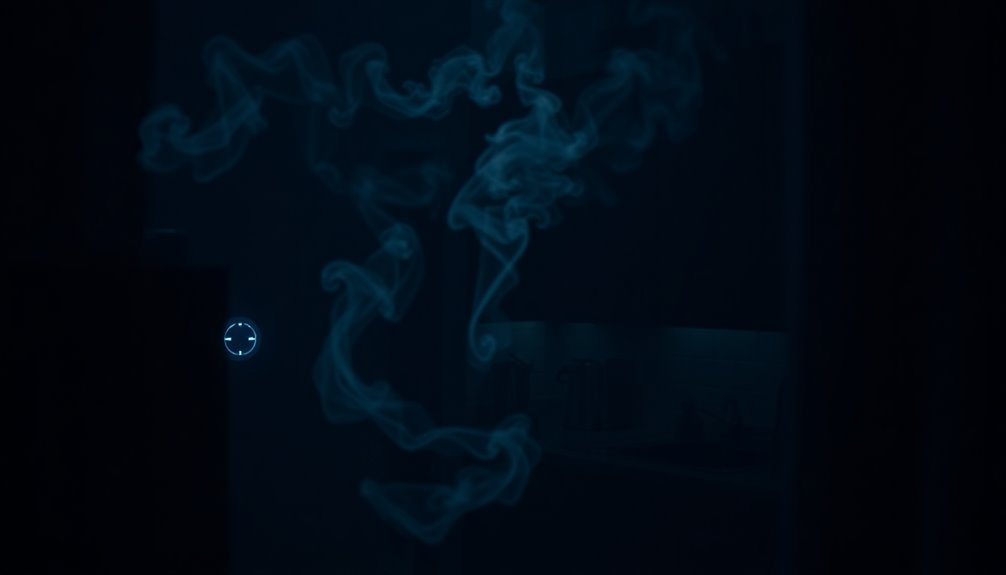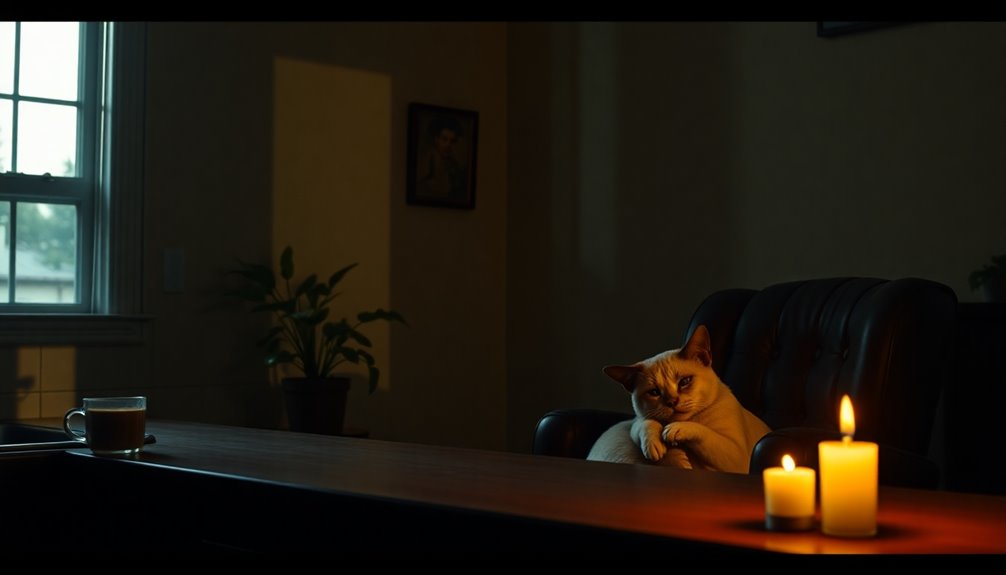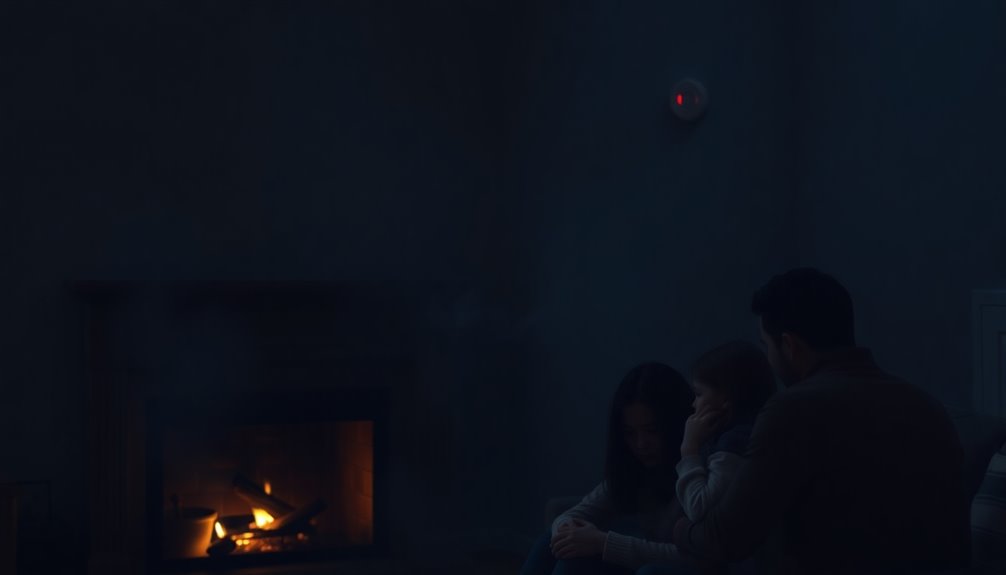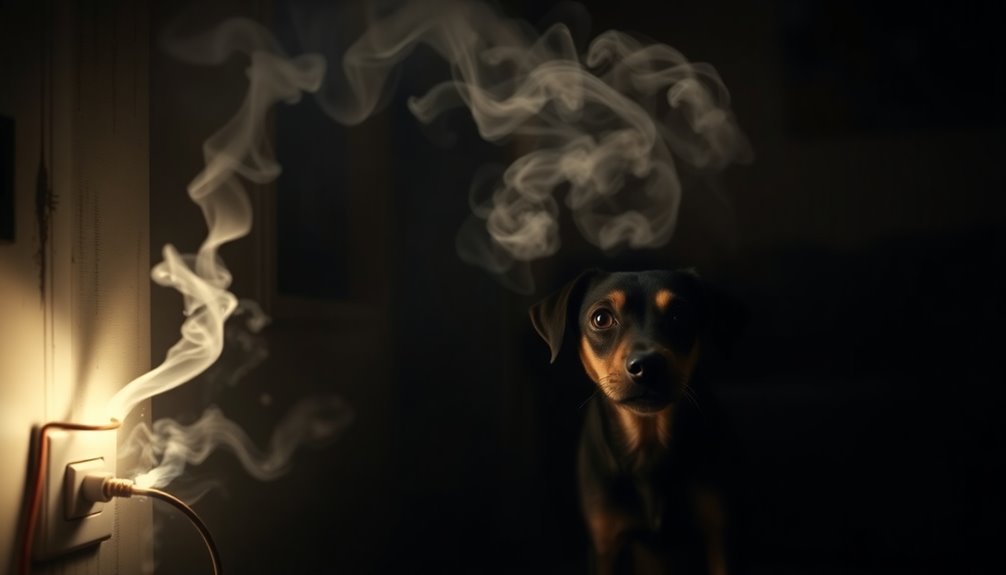Carbon monoxide doesn't have a smell, so you won't detect it in your house through your nose. It's a colorless, odorless gas that can sneak up on you, often produced by malfunctioning gas appliances or incomplete combustion from fuels. Since you can't smell it, it's crucial to rely on CO detectors for safety. If you notice symptoms like headaches or dizziness, you might be at risk. Always keep your appliances maintained and ensure proper ventilation to avoid dangerous situations. Stay informed about prevention measures to keep your home safe and healthy.
Key Takeaways
- Carbon monoxide (CO) is colorless and odorless, so it cannot be detected by smell.
- Without specialized equipment, you cannot smell CO in your house.
- Symptoms of CO exposure may mimic flu-like conditions, not a distinct smell.
- Yellow or orange flames and dark soot around appliances indicate possible CO presence.
- Installing CO detectors is essential for early warning and safety in your home.
Introduction

Carbon monoxide (CO) is a silent threat in many homes. This colorless, odorless gas can be incredibly dangerous, and you might not even realize it's there. Unlike natural gas, which has a distinct rotten egg smell due to added odorants, CO gives no warning. It can accumulate from malfunctioning appliances or incomplete combustion, putting you and your loved ones at risk.
To ensure your safety, it's crucial to install carbon monoxide detectors throughout your home. These devices alert you to dangerous levels of CO, allowing you to take action before exposure leads to serious health issues or even fatalities. Regularly check and maintain your appliances to prevent potential leaks, and always be aware of the signs of CO buildup, such as headaches, dizziness, or confusion.
Since CO is tasteless and undetectable by sight, relying on your senses isn't enough. Awareness of this dangerous gas's characteristics is vital. By prioritizing safety measures, you can protect yourself and your family from the hidden risks associated with carbon monoxide in your home. Remember, prevention starts with knowledge and the proper tools.
Description of the Smell

Often overlooked, the fact is that carbon monoxide has no smell at all. This odorless gas, known as CO, poses a significant danger because it can accumulate in your home without you ever detecting it. Unlike natural gas, which is intentionally given a rotten egg smell for safety reasons, carbon monoxide offers no warning signs.
High levels of CO can build up, especially in enclosed spaces, making it crucial to have carbon monoxide detectors installed. If there's a leak or malfunctioning appliance, you won't smell anything until it's too late. This absence of scent means that you could be exposed to carbon monoxide gas without realizing it, leading to serious health risks.
While other exhaust gases may have noticeable odors, such as the smell of natural gas, CO itself remains completely undetectable by your senses. Prolonged exposure can cause symptoms that mimic other illnesses, adding to the danger. To stay safe, make sure you regularly check your detectors and stay vigilant about potential sources of carbon monoxide in your home. Don't take any chances—ensure your safety by being proactive.
Source and Composition

Understanding the sources of carbon monoxide (CO) is vital for maintaining a safe home environment. This odorless gas is produced by the incomplete combustion of fuels like wood, gasoline, propane, and charcoal. Since CO lacks any detectable odor, it can silently accumulate in your home without you knowing, making carbon monoxide detectors essential for your safety.
Common sources of CO include malfunctioning gas appliances, such as furnaces, stoves, and water heaters. When these appliances don't operate correctly, they can emit CO alongside other combustion byproducts. Additionally, blocked chimneys can trap exhaust gases indoors, leading to dangerous levels of CO. It's also crucial to be mindful of vehicles running in attached garages, as their exhaust can quickly infiltrate your living space.
Awareness of these sources of CO is critical because the gas can build up in enclosed areas, posing a significant risk of poisoning or even fatality. Regular maintenance of gas appliances and ensuring proper ventilation can help mitigate these dangers. Always prioritize safety by installing and regularly checking your carbon monoxide detectors to protect yourself and your loved ones.
Typical Scenarios or Environments

In many homes, certain scenarios can signal the presence of carbon monoxide, even though the gas itself is undetectable. One typical scenario involves malfunctioning gas appliances. If you notice yellow or orange flames instead of the expected blue flames, it's an indicator of incomplete combustion, suggesting potential carbon monoxide leaks. Additionally, dark, sooty stains around your appliances or frequent pilot light outages can also be alarming signs of carbon monoxide.
Running vehicles in an attached garage can further contribute to CO buildup, especially if the space is poorly ventilated. Blocked chimneys can trap dangerous gases indoors, making it essential to check these regularly. Increased condensation on your windows or slower-burning solid fuel fires may serve as additional indicators of carbon monoxide in your home.
To stay safe, it's crucial to install carbon monoxide detectors throughout your living spaces. These devices provide peace of mind by alerting you to the presence of this invisible threat, allowing for timely action. By being aware of these signs of carbon monoxide and understanding typical scenarios, you can better protect yourself and your loved ones from its dangers.
Emotional or Cultural Associations

Carbon monoxide (CO) carries a weighty emotional burden for many people due to its invisible and odorless nature. The fear of hidden dangers linked to CO exposure can evoke strong emotional responses, especially among parents and caregivers who strive to protect their family. You might find yourself feeling anxious about whether your carbon monoxide detectors are placed correctly, realizing they are your first line of defense against this silent threat.
Culturally, the recognition of CO as an odorless gas has led to increased awareness campaigns that emphasize the need for vigilance. These campaigns encourage you to understand that while CO may not smell, it poses significant risks requiring proactive measures. Community programs often educate families about the importance of venting carbon monoxide safely and the necessity of regular detector checks.
As you engage with these resources, you're reminded that impaired judgment can result from CO exposure, making it crucial to stay informed. By taking these steps, you not only keep your family safe but also foster a collective responsibility within your community, ensuring everyone is prepared to handle this invisible danger.
Health or Safety Considerations

The dangers of carbon monoxide (CO) exposure can't be underestimated, especially since this gas is both odorless and colorless, making it nearly impossible to detect without proper equipment. A carbon monoxide leak can lead to serious health issues, including carbon monoxide poisoning, which claims around 400 lives annually in the U.S. Without CO detectors, you might not even realize there are dangerous levels of carbon monoxide in your home.
It's crucial to install and maintain these detectors properly to ensure they work effectively. Make sure you place them in key areas, like near sleeping spaces, where you're most vulnerable. Symptoms of carbon monoxide can mimic other illnesses, like headaches, dizziness, and nausea, which often leads to delayed action. Recognizing these symptoms is vital, but relying solely on them can be risky.
If you ever suspect a carbon monoxide leak, don't hesitate to call us. Timely intervention is essential to safeguard your health and safety. Be proactive about detecting carbon monoxide; it's not just about peace of mind—it's about protecting yourself and your loved ones from potentially fatal exposure.
Final Thoughts

Ensuring your home is safe from carbon monoxide is essential for your well-being and peace of mind. Carbon Monoxide (CO) poisoning is a serious risk that can occur without you even knowing it, as CO is a silent killer—odorless and tasteless. You can't rely on your senses to detect its presence, so it's crucial to have carbon monoxide detectors throughout your home.
Pay special attention to areas near gas stoves and heating equipment, where indoor CO levels can rise unexpectedly. Regular maintenance of your appliances can help prevent dangerous leaks, ensuring your home remains a safe environment. If you ever experience symptoms like headaches or dizziness, it's vital to leave your home immediately and seek fresh air, as these could be signs of CO exposure.
Frequently Asked Questions
How Do You Know if Your House Smells Like Carbon Monoxide?
You can't actually smell carbon monoxide, so relying on your senses isn't enough. Instead, watch for signs like yellow or orange flames from appliances and dark soot stains, which can indicate issues. If you notice unusual condensation on windows or your solid fuel fire burns slower, these might signal a buildup. To stay safe, install carbon monoxide detectors and maintain your fuel-burning appliances for proper ventilation and early detection.
What Are Two Warning Signs of Carbon Monoxide Poisoning?
Two warning signs of carbon monoxide poisoning are yellow or orange flames from your gas appliances and dark, sooty stains around them. If you notice your appliances aren't burning with that typical blue flame, it's time to investigate further. Also, if you find yourself frequently relighting pilot lights, it could indicate a problem with gas combustion, increasing your risk of exposure to this dangerous gas. Stay vigilant and ensure you have a CO detector!
How Do You Tell if There Is a Carbon Monoxide Leak in Your Home?
To tell if there's a carbon monoxide leak in your home, watch for warning signs. You might notice yellow or orange flames from your gas appliances instead of blue, or see dark soot around burners. If you experience frequent pilot light outages or increased condensation on your windows, these could indicate a problem. Regularly inspect your fuel-burning appliances and install CO detectors to keep your home safe from this dangerous gas.
How Do You Detect Carbon Monoxide Without a Detector?
You can't detect carbon monoxide (CO) without a detector, since it's odorless and tasteless. However, you can look for signs that might indicate its presence. Check for yellow or orange flames in gas appliances, dark stains around them, or frequent pilot light outages. Increased condensation on windows and symptoms like headaches or dizziness could also signal a problem. Regularly inspect fuel-burning appliances and ensure proper ventilation to minimize risks.









